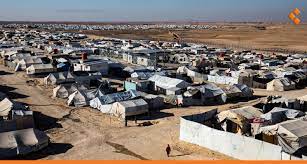Sources within the al-Hol camp, situated in the northern countryside of Hasakeh, have reported a sudden cessation of murders within the camp. They explain that there is no longer any noticeable activity from ISIS cells, which were previously active in enforcing the extremist organization’s rules upon the camp’s residents. The population of the camp, which once reached approximately 70,000, has gradually decreased to around 51,000 individuals.
Information obtained by Athr Press indicates that organizations operating within the camp have informed the Syrian Democratic Forces (SDF), who control the camp, of their intention to withdraw if the security issues persist. Consequently, some of these organizations have ceased their activities, particularly out of concern for their foreign staff.
Regime Continues Arrests and Torture Despite International Justice Decision
In response to this security concern, sources close to the camp administration, who preferred to remain anonymous, revealed to Athr Press that the US Forces Command, through a series of visits to the camp, presented the SDF with two options: either to resolve the security chaos internally or to allow the formation of a faction by the Americans, independent of the SDF, to solely manage and ensure security within the camp.
In terms of crime statistics, approximately 113 murders were recorded in 2021, followed by 93 in 2022. However, since the beginning of 2023 until the present, no crimes have been reported. Additionally, the so-called Hisba apparatus, responsible for patrolling the foreigners’ wing and enforcing strict dress codes, has vanished from public view.
Several months ago, the SDF initiated a security crackdown by arresting leaders of the camp guard Asayish on charges of smuggling weapons, incendiary and explosive materials, and mobile devices into the camp. This crackdown also targeted the smuggling of materials by tankers and car drivers contracted with various organizations. The SDF increased the number of camp guards and collaborated with residents to locate hidden weapons and ammunition, as well as identify extremist figures. This concerted effort significantly hampered the activity of extremist cells.
Security stability has notably improved after US forces compelled the SDF to relocate the majority of foreigners to the Rojava camp, thereby alleviating pressure and reducing the likelihood of ISIS activity.
These strategic maneuvers by the SDF and US forces stem from concerns about the potential withdrawal of organizations from the camp, which could escalate the financial burden of their continued presence in Syrian territory. Withdrawal of humanitarian organizations would necessitate that the SDF assume the financial responsibilities previously borne by these organizations.
It’s worth mentioning that on August 23, 2023, the commander of the US Central Command, General Michael Kurilla, visited both the Hol and al-Roj camps, where he met with camp directors and residents. Furthermore, on the 16th of the same month, former US Secretary of Defense Christopher Miller visited eastern Syria and held discussions with the co-chairs of the Department of Foreign Relations in the Autonomous Administration of North and East Syria, emphasizing the importance of providing necessary support to address issues related to ISIS prisons and camps in northeastern Syria, particularly the Hol camp.
This article was translated and edited by The Syrian Observer. The Syrian Observer has not verified the content of this story. Responsibility for the information and views set out in this article lies entirely with the author.


